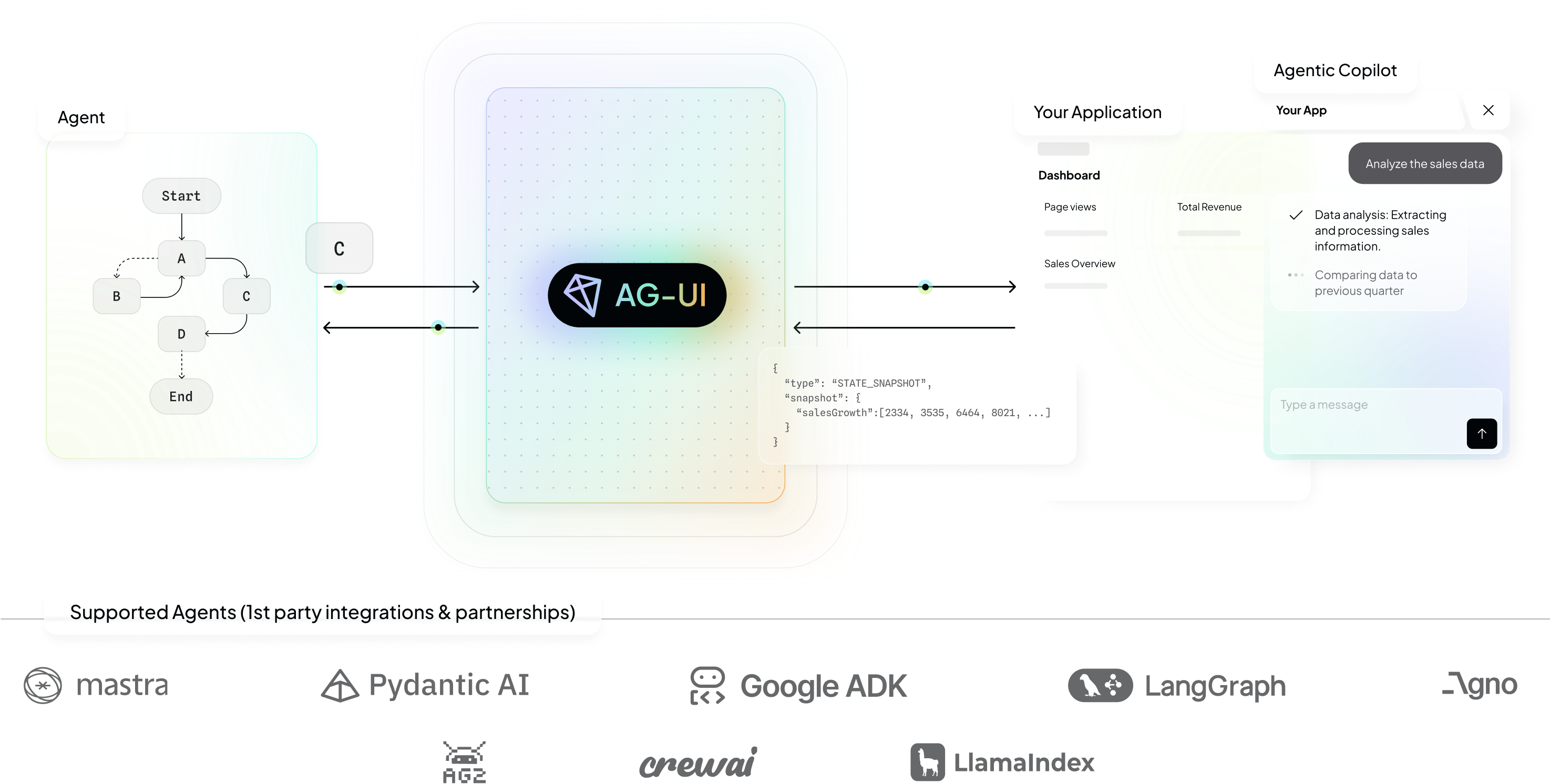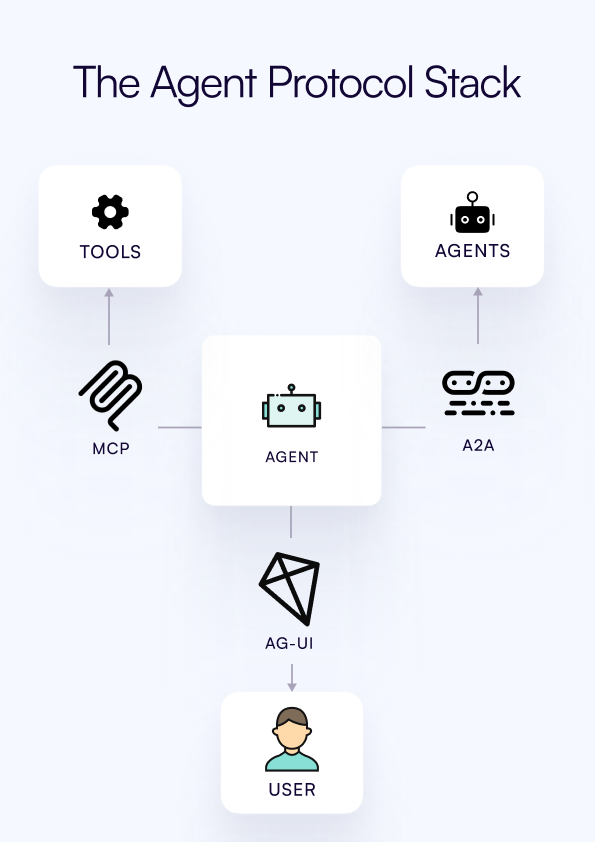The Agent–User Interaction (AG-UI) Protocol
AG-UI is an open, lightweight, event-based protocol that standardizes how AI agents connect to user-facing applications. Built for simplicity and flexibility, it standardizes how agent state, UI intents, and user interactions flow between your model/agent runtime and user-facing frontend applications—to allow application developers to ship reliable, debuggable, user‑friendly agentic features fast while focusing on application needs and avoding complex ad-hoc wiring.
Building blocks (today & upcoming)
Why Agentic Apps need AG-UI
Agentic applications break the simple request/response model that dominated frontend-backend development in the pre-agentic era: a client makes a request, the server returns data, the client renders it, and the interaction ends.The requirements of user‑facing agents
While agents are just software, they exhibit characteristics that make them challenging to serve behind traditional REST/GraphQL APIs:- Agents are long‑running and stream intermediate work—often across multi‑turn sessions.
- Agents are nondeterministic and can control application UI nondeterministically.
- Agents simultanously mix structured + unstructured IO (e.g. text & voice, alongside tool calls and state updates).
- Agents need user-interactive composition: e.g. they may call sub‑agents, often recursively.
- And more…
The AI protocol landscape
AG-UI has emerged as the 3rd leg of the AI protocol landscape:
- MCP: Connects agents to tool and to context.
- A2A: Connects agents to other agents.
- AG-UI: Connects agents to users (through user-facing applications)
AG-UI in action
You can see demo apps of the AG-UI features with the framework of your choice, with preview, code and walkthrough docs in the AG-UI Dojo
Supported Integrations
AG-UI was born from CopilotKit’s initial partnership with LangGraph and CrewAI - and brings the incredibly popular agent-user-interactivity infrastructure to the wider agentic ecosystem.Direct to LLM
| Framework | Status | AG-UI Resources |
|---|---|---|
| Direct to LLM | Supported | Docs |
Agent Framework - Partnerships
Agent Framework - 1st Party
| Framework | Status | AG-UI Resources |
|---|---|---|
| Mastra | Supported | Docs, Demos |
| Pydantic AI | Supported | Docs, Demos |
| Agno | Supported | Docs, Demos |
| LlamaIndex | Supported | Docs, Demos |
| AG2 | Supported | Docs |
| AWS Bedrock Agents | In Progress | – |
| AWS Strands Agents | In Progress | – |
| Microsoft Agent Framework | In Progress | – |
Agent Framework - Community
| Framework | Status | AG-UI Resources |
|---|---|---|
| Vercel AI SDK | Supported | Docs |
| OpenAI Agent SDK | In Progress | – |
| Cloudflare Agents | In Progress | – |
Agent Interaction Protocols
| Protocol | Status | AG-UI Resources | Integrations |
|---|---|---|---|
| A2A Middleware | Supported | Docs | Partnership |
SDKs
| SDK | Status | AG-UI Resources | Integrations |
|---|---|---|---|
| Kotlin | Supported | Getting Started | Community |
| Golang | Supported | Getting Started | Community |
| Java | Supported | Getting Started | Community |
| Rust | Supported | Getting Started | Community |
| .NET | In Progress | PR | Community |
| Nim | In Progress | PR | Community |
| Dart | In Progress | PR | Community |
| Flowise | In Progress | GitHub Source | Community |
| Langflow | In Progress | GitHub Source | Community |
Clients
| Client | Status | AG-UI Resources | Integrations |
|---|---|---|---|
| CopilotKit | Supported | Getting Started | 1st Party |
| Terminal + Agent | Supported | Getting Started | Community |
| React Native | Help Wanted | GitHub Source | Community |
Quick Start
Choose the path that fits your needs:Build agentic applications
Build agentic applications powered by AG-UI compatible agents.
Build new AG-UI integrations
Build integrations for new agent frameworks, custom in-house solutions, or use AG-UI without any agent framework.
Build AG-UI compatible clients
Build new clients for AG-UI-compatible agents (web, mobile, slack, messaging, etc.)
Explore AG-UI
Dive deeper into AG-UI’s core concepts and capabilities:Core architecture
Understand how AG-UI connects agents, protocols, and front-ends
Events
Learn about AG-UI’s event-driven protocol
Resources
Explore guides, tools, and integrations to help you build, optimize, and extend your AG-UI implementation. These resources cover everything from practical development workflows to debugging techniques.Developing with Cursor
Use Cursor to build AG-UI implementations faster
Troubleshooting AG-UI
Fix common issues when working with AG-UI servers and clients
Contributing
Want to contribute? Check out our Contributing Guide to learn how you can help improve AG-UI.Support and Feedback
Here’s how to get help or provide feedback:- For bug reports and feature requests related to the AG-UI specification, SDKs, or documentation (open source), please create a GitHub issue
- For discussions or Q&A about the AG-UI specification, use the specification discussions
- For discussions or Q&A about other AG-UI open source components, use the organization discussions